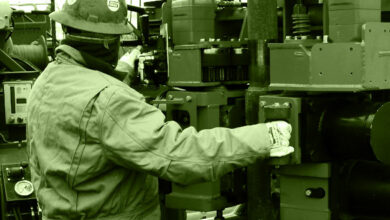Technical Session 7 – Drilling Dynamics
Editor’s note: These abstracts have been edited for space and clarity. This program is current as of 15 January 2013. Additions, withdrawals and other changes to the conference program after this date may not be reflected. Click here for the most updated program.
TECHNICAL SESSION 7: DRILLING DYNAMICS
SPE/IADC 163565
Little Things, Big Effects – Identifying Causes and Addressing Vibrations Issues in Challenging Deepwater Applications, G. Mensa-Wilmot, P. Benet, B. Maddoux, D. Ramchune, Chevron
This paper identifies a major contributor to drilling vibrations that is often overlooked in the types of analysis mentioned earlier – geometries of downhole tools, especially stabilizers. This realization is based on extensive analysis of worn tools. Correlations between specific vibrations modes, their initiation factors and failure patterns on downhole tools are established. Low-cost remediation solutions, that focus primarily on modifications to downhole tool geometries (little things), and the positive results they have had on the issues discussed earlier (big effects) will be discussed. Worldwide deepwater projects and results, following the new changes, will be presented.
SPE/IADC 163477
Drill String Analysis with a Discrete Torque-Drag Model, R. Mitchell, Halliburton
In the standard torque-drag model, the drill string shape is taken as the wellbore shape. However, given that the most common method for determining the wellbore shape is the minimum curvature method, this assumed wellbore shape forces the bending moment to be discontinuous at survey points. This defect is dealt with by neglecting the bending moment.
A different approach assumes that the drill string position corresponds with the minimum curvature wellbore only at discrete points. The paper gives a complete description of the drill string calculation. Typical torque drag problems with different inclinations and wellbore curvatures are studied to compare the two torque-drag formulations. These studies give comparisons in drag forces, torques for the two models and for the new formulation, the magnitude of the bending moments.
SPE/IADC 163420
Drill String Mechanics Model for Surveillance, Root Cause Analysis, and Mitigation of Torsional and Axial Vibrations, D. Ertas, J.R. Bailey, L. Wang, P.E. Pastusek, ExxonMobil
Case studies utilizing high-frequency surface/downhole drilling mechanics data validated a general purpose drill string mechanics model and identified three types of torsional dysfunctions with distinct signatures and mitigators: unstable stick-slip, bit/BHA stall and synchronous torsional oscillation.
SPE/IADC 163503
Design Evolution of Drilling Tools to Mitigate Vibrations, J.R. Bailey, R.W. James, P.E. Pastusek, M. Prim, ExxonMobil; C.C. Elsborg, Esso Norge A/S
The development of methods to characterize the relative vibration tendency of alternative bottom-hole assemblies has enabled deliberate tool redesign to reduce vibrations. Tool redesign is most effective if applied early in the tool design cycle, where important configuration parameters are most easily adjusted. This paper outlines several design issues to resolve so that the next generation of tools has inherently lower vibration levels.
E-POSTERS:
SPE/IADC 161155
Solving Stick-Slip Dilemma: Dynamic Modeling System Significantly Reduces Vibration, Increases ROP by 54%, A. Mohaideen, F.H. Bakar, N. Abd Rahman, Petronas Carigali; K.H. Tang, R. Maury, P. Cox, P. Le, H. Donald, B. Subroto, E. Brahmanto, Schlumberger
In mid-2010, Petronas Carigali started a drilling campaign of a green field development at the Malay Basin, offshore Peninsular Malaysia. The operator drilled a borehole through a challenging interbedded formation with hard dolomite stringers to access natural gas reserves in one of the fields. This paper details the collaboration and integrated approach of the service company in determining vibration issues and solving the problem, hence enhancing the drilling performance of future wells.
SPE/IADC 163464
Pre-Job Modeling/Resulting Integrated BHA System Solution Sets Multiple ROP Records, North Field Qatar, M. Kieschnick, T. Jacob, B. James, Schlumberger; V. Karuppiah, R. Hamilton, Smith Bits, a Schlumberger Company
Drilling the 12¼-in. tangent section through thick carbonate lithology in Qatar’s North Field is exceptionally challenging. An FEA-based modeling system, rock strength identification program and CFD analysis was used to investigate several 12¼-in. PDC bit designs. The results of the simulations led to a new MSi716 design with back-up cutters strategically positioned on all blades to provide maximum durability in critical wear areas. Based on outstanding bit performance, the operator made these design changes a standard requirement for PDC bits in this application. The new design also helped standardize MSE values for future ROP gains.



